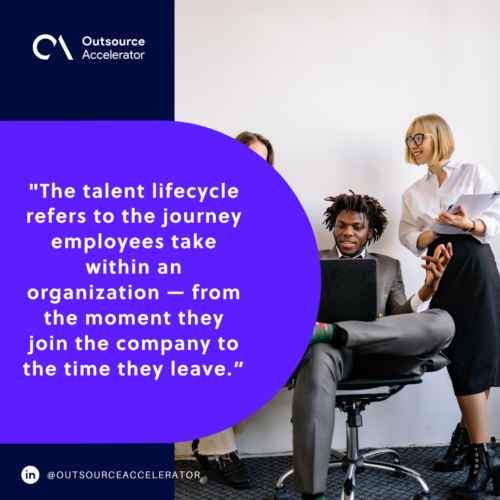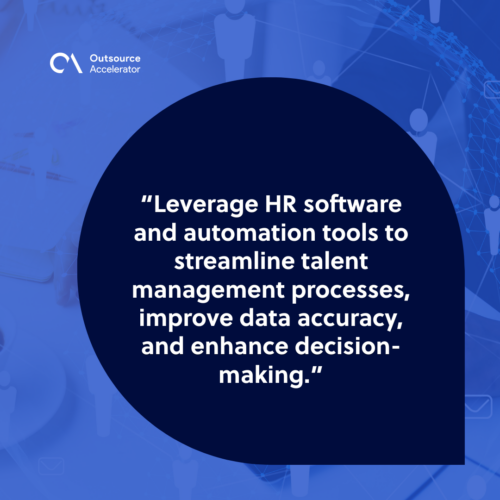Breaking down the stages of the talent lifecycle

When it comes to building a successful team, it’s essential to understand and manage the talent lifecycle effectively.
From attracting top talent to positively saying goodbye, every stage plays a crucial role in your organization’s overall success.
Let’s further dive into what the talent lifecycle entails, its importance, and the stages involved. We’ll also share best practices for managing your employees’ journeys.
What is the talent lifecycle?
The talent lifecycle refers to the journey employees take within an organization — from the moment they join the company to the time they leave.
It encompasses the processes and practices involved in attracting, developing, and retaining high-performing individuals.
By understanding and optimizing each stage of the employee lifecycle, companies can ensure a smooth and efficient flow of talent within their workforce.

Importance of the talent lifecycle
Managing the talent lifecycle effectively is vital for several reasons. Let’s break down the benefits into specific areas:
Amped-up productivity
By really understanding how each stage of the talent journey works and making it run smoother; companies can keep talent flowing through their teams like a well-oiled machine.
This means people get better at what they do thanks to support and growth at every step.
Satisfied employees
A smart talent lifecycle strategy takes care of folks at every point in their career journey. This leads to higher job satisfaction, increased engagement, and a positive work environment.
A Gallup report emphasized how the most successful organizations focus on employee engagement in their business strategies. As a result, workers who’ve been given clear expectations and proper support do their best work.
Less employee turnover
The talent lifecycle is all about keeping people growing and sticking around, which can mean they’re more loyal and less likely to leave.
By focusing on employee retention, companies can save a lot on hiring and training costs.
Snag top talent
A solid talent acquisition process can attract the right people with the necessary skills and smarts.
Data-driven methods, like psychometric assessments or applicant tracking systems, can make recruiting more accurate and efficient.

Positive impact on the bottom line
At the end of the day, managing the talent pipeline well can seriously boost the bottom line.
By attracting, nurturing, and holding onto top performers, companies can:
- Improve productivity
- Cut costs tied to turnover
- Stay ahead of the competition
Development of future leaders
Forbes emphasized the importance of aligning learning programs to business goals and upskilling employees.
Linda Jingfang Cai, LinkedIn’s VP of Talent Development, noted in the piece that both of those undertakings have become the top priorities of learning and development teams.
So, by nurturing talent along the way, companies can spot and develop the leaders of tomorrow. This keeps things steady and strong for the long haul.
5 stages of the talent lifecycle
Strategic talent management is all about creating helpful processes and policies for your team. So, it’s crucial to think about how each person will feel and understand the rules and tools you set up.
Keeping that in mind, let’s dive into the five stages of the employee lifecycle:
1. Talent acquisition
The talent acquisition stage involves sourcing, attracting, and selecting candidates to fill open positions within the organization. It starts with defining job roles and requirements, followed by posting job listings, conducting interviews, and making hiring decisions.
Leveraging technology, like applicant tracking systems and social media platforms, can streamline this process and help identify the best candidates efficiently.
2. Onboarding and orientation
Once a candidate is hired, the onboarding and orientation stage begins. This phase is crucial for setting new employees up for success by introducing them to the organization’s culture, values, policies, and procedures.
Effective onboarding programs help new hires feel welcomed, integrated, and equipped with the necessary tools and knowledge to perform their roles effectively from day one.
3. Performance management and employee development
Performance management involves:
- Setting expectations
- Providing feedback
- Evaluating performance
- Identifying opportunities for improvement
Employee development initiatives, like training, coaching, and mentoring programs, are also essential to help employees enhance their skills, knowledge, and capabilities. These ultimately contribute to their professional growth and career advancement.
4. Employee retention and succession planning
Employee retention is critical for maintaining a stable and engaged workforce. Companies can foster retention by:
- Offering competitive compensation and benefits
- Creating a positive work environment
- Providing opportunities for career advancement
- Recognizing and rewarding employees for their contributions
Meanwhile, succession planning involves identifying and developing internal talent to fill key leadership positions in the future. This ensures continuity and stability within the organization.
According to Harvard Business Review, poor succession planning could lead to a significant loss not only in talent but also in resources. The report revealed that badly-handled CEO and C-suite changes in the S&P 1500 cost nearly $1 trillion annually.
5. Offboarding and outreach
The offboarding stage occurs when an employee leaves the organization, whether due to resignation, retirement, or termination.
At this phase, it’s essential to:
- Conduct exit interviews to gather feedback
- Do knowledge transfer sessions to document critical information
- Facilitate a smooth transition for both the departing employee and their colleagues
Maintaining positive relationships with former employees through alumni networks and outreach efforts can also provide benefits in the long run.
Talent lifecycle management best practices
To effectively manage the talent lifecycle, consider implementing the following best practices:
1. Develop a comprehensive talent strategy. Align your talent management practices with your organization’s goals and objectives to ensure coherence and effectiveness.
2. Invest in technology. Leverage HR software and automation tools to streamline talent management processes, improve data accuracy, and enhance decision-making.

3. Promote a culture of continuous learning. Encourage employees to pursue ongoing learning and development opportunities to stay relevant and adaptable.
4. Prioritize employee well-being. Support employee well-being through flexible work arrangements, wellness programs, and initiatives that promote work-life balance.
5. Foster open communication. Create channels for regular feedback, dialogue, and collaboration to foster a culture of transparency, trust, and engagement.
6. Embrace diversity and inclusion. Create an environment that champions diversity and inclusivity. This ensures every team member feels appreciated, respected, and empowered to contribute their individual viewpoints and skills.
7. Stay agile and adaptable. Remain flexible and responsive to changing market conditions, technological advancements, and evolving workforce dynamics to stay ahead of the curve and maintain a competitive edge.
Elevate your talent lifecycle strategy
By embracing the talent lifecycle, you can optimize human resources practices and ensure the continuous growth and success of your workforce. You can also enlist the aid of a firm like Booth & Partners to enhance your recruitment efforts.
Companies can then boast a competitive advantage as a result of attracting, developing, and retaining high-performing individuals.
It’s crucial to regularly reassess and improve talent lifecycle strategies to adapt to changing market trends. Paying attention to it also helps meet the evolving needs of employees and the organization as a whole.







 Independent
Independent




